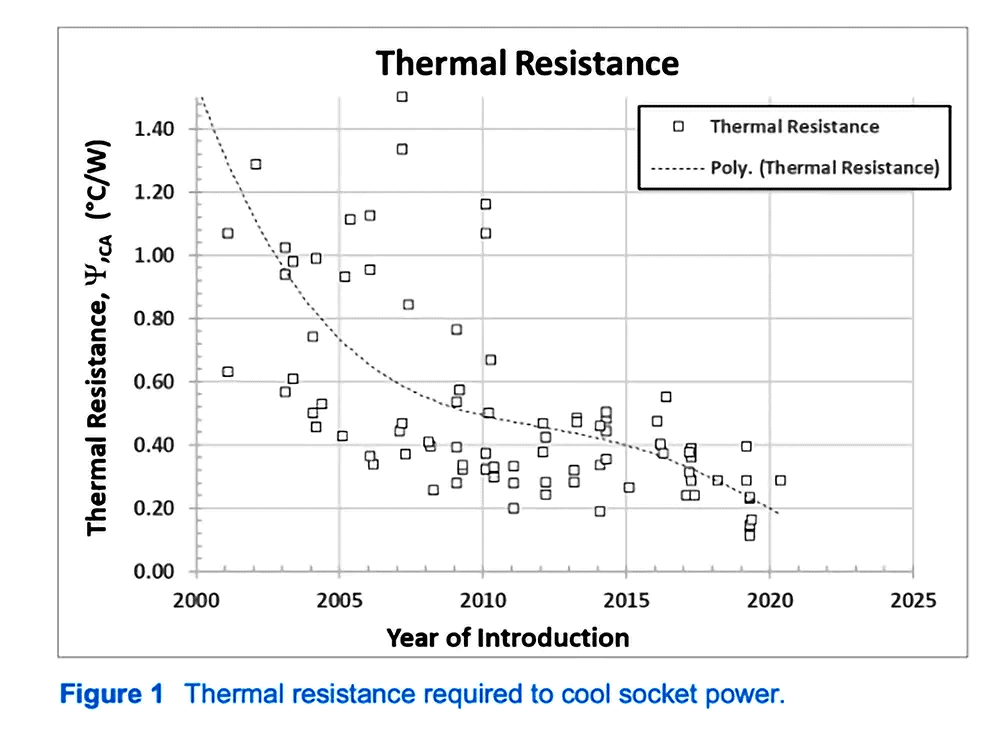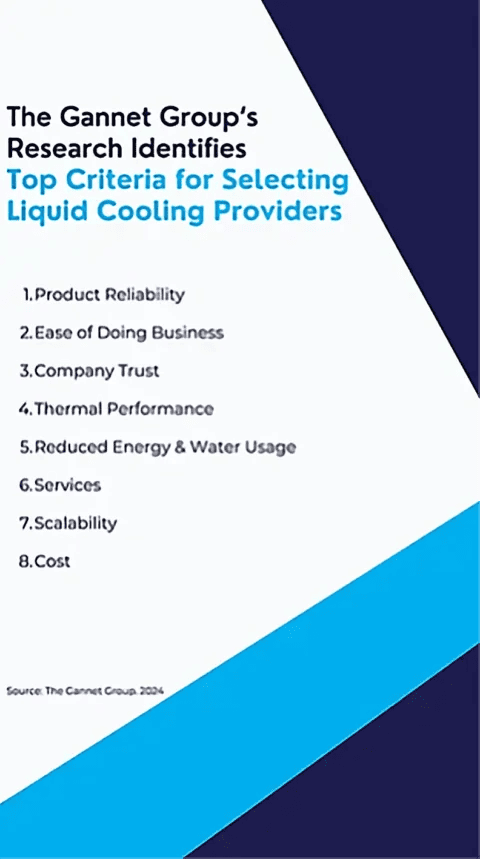
by
Jordan Sutlive
A Cooling Crisis
Cooling solutions for the data center now arrive at an inflection point. With rapid advancements in AI and rack density, alongside an increased reliance on high-powered GPUs, data centers are consuming more power than ever—so much so that they’re predicted to run out of power in two years, experts warn. Amidst this power crisis, data centers face an increased urgency to harness waste heat and keep critical equipment cool—and to do so efficiently and sustainably.
Power demands cooling—and our data centers demand better cooling solutions. The relationship between an increase in power and, as ASHRAE describes it, an increased “degree of difficulty for cooling” is perhaps best illustrated through the diagram below. A consistent uptick in “socket power” (herein described as the power demand placed on a device) has steadily occurred since the start of the 21st century. This rising socket power requires a decreased thermal resistance, which in turn requires improvements in cooling solutions. This is true whether the solution is air- vs. liquid-based, or single-phase vs. two-phase.

Simply put: if we want our AI and CPUs and GPUs to continue to evolve, so too must our cooling. It’s become clear that traditional cooling methods no longer work as de facto solutions. The time for innovation is now. And, the research indicates, the first domino to fall is air-based cooling.
It’s Just Physics
During a recent Data Center Dynamics webinar, Nvidia’s Director of Technical Design Ali Heydari commented: “We have been living with air for 70 years. Air is lazy…The laws of physics dictate we move from air to liquid cooling.”
The industry has scraped against the limits of air-based cooling for years. ASHRAE indicates that air becomes increasingly inadvisable as a cooling solution as socket power moves through 300W towards 400W. This is largely due to its comparably low thermal conductivity, which is a critical quality for transferring heat from key infrastructure. Meanwhile, water is 23.5 times more efficient in moving heat than air.
With this data, a recommended switch from air- to water-based cooling seems obvious. Yet utilizing water alone isn’t without its drawbacks. Beyond its limitations as a coolant—it can only be chilled to just above freezing, after all—a water-based system can lead to catastrophe if leaks occur. As such, a dielectric refrigerant, which won’t damage servers or IT equipment in case of leaks, and often performs better in high-density environments, tends to be favored in lieu of water.
Two is Better than One
Liquid cooling occurs throughout the industry in one of two forms: single-phase or two-phase. Single-phase relies solely upon liquid in its liquid state to cool key equipment, whereas two-phase harnesses both liquid and, once the liquid boils, its resultant vapor.
Two-phase’s optimization of resources can avoid the strain caused by needlessly high flow rates and ultimately lead to a safer, more durable cooling solution. According to Lucas Beran, Dell’Oro’s Group Research Director, single-phase’s use of only liquid may increase the risk of eroding key cooling system components, especially at higher flow rates. Meanwhile, Steven Hill noted that two-phase’s ability to remove heat via a sensible and latent heat of vaporization allows it in part to require 4X-9X less flow rate at the chip compared to a single-phase, water-based cooling solution.
Heydari similarly noted the limitations of single-phase. In his DCD webinar, Heydari predicted that single-phase will be phased out in favor of two-phase within the next 5-7 years, a comment that elicited a nod of approval from Dr. Dev Kulkarni, Intel’s Senior Principal Engineer and Thermal Architect. In an interview with Data Center Knowledge, Kulkarni added: “It’s important to think two or three generations ahead. If you go all out on single-phase only, you might find you need to switch some infrastructure to two-phase technologies within a short period.”
The Next Generations of Cooling
Throughout this cooling revolution, the objectives remain the same: in the midst of growing power demands, data centers require a cooling solution that is reliable, resilient, and responsive, all while prioritizing efficiency to allow power to be utilized where it’s needed most. While the journey continues, the research has clearly indicated which trends can lead to better cooling:
- Compared to air, liquid-based cooling offers higher thermal conductivity and greater efficiency in heat removal.
- Compared to water, a dielectric refrigerant has a higher cooling potential and doesn’t require downtime needed to prevent biofouling and contamination.
- Compared to single-phase, the versatility of a two-phase system enhances a cooling system’s efficacy and lowers the risk of wear and tear.
An optimal cooling product isn’t merely about its performance, however. Leading consulting firm The Gannet Group highlighted the top key factors that data center and IT buyers consider when exploring and potentially adopting a new cooling solution. Beyond solution-focused elements like thermal performance and reduced energy & water usage, the study’s findings also emphasized how much customers care about the ease of doing business, company trust, services, scalability, and cost. In short, it isn’t enough for a solution to be reliable—the solution provider has to be reliable, too.

Very few cooling solutions have emerged in the market that are liquid-based, two-phase, and utilize a sustainable dielectric refrigerant. Fewer still are backed by companies who seek to exceed their customers’ needs. One such product, however, is the NeuCool cooling system from Accelsius.
In response to current power demands, the NeuCool system provides denser processing and more effective cooling, which guarantees more compute power and revenue per area/volume and drives its PUE (or Power Usage Effectiveness) closer to 1.0. Meanwhile, its dielectric fluid prevents damage in case of leaks and will enhance your company’s sustainability initiatives.
Beyond the product’s innovative components and design, which emphasizes resiliency and reliability, our team at Accelsius aims to respond to the unique needs of mission-critical data centers throughout each stage of the installation and implementation process. We offer white-glove services to our valued partners, and our North American-based supply chain affords faster unplanned response times in the event of a crisis. We don’t view these offerings as a luxury; rather, for our customers, we consider them a necessity. Our industry is undergoing a cooling revolution, and we’ve built a company which aims to encompass and embody the benefits of emerging positive trends in the liquid cooling market.